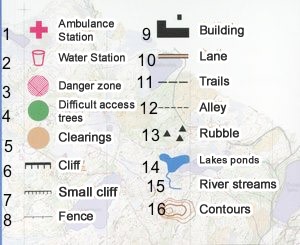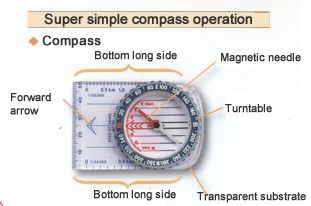What is Orienteering?
The lands in Norway and Sweden are covered in fairy-tale like vast forests, with lakes and villages scattered in them. Trails between villages are not clearly constructed, it is very dangerous to travel through an unknown area (forest). Hence, the idea of orienteering originated from Sweden in 1886, and was spread out by American boy scouts. Orienteering is popular in UK, Canada, Australia, Germany, France, Japan, etc. Today, the International Orienteering Federation (IOF) has 63 country members; parts of orienteering section have been listed in the Winter Olympics. The sport gained its popularity as the techniques are easy to learn, and being close to nature is beneficial for physical and mental health. It is suitable for people of all ages (from seven-year-olds to elderly). There is even a wheelchair orienteering!
Frequently used diagrams in Orienteering Maps
1.First Aid Station
2.Water Supply Station
3.Dangerous Zone
4.Woods hard to travel through
5.Wilderness
6.Cliff
7.Small cliff (passable)
8.Fence
9.Building
10.Driveway
11.Walking path
12.Walking trail
13.Rock piles
14.Lakes, ponds
15.rivers, streams
16.Contour lines

Methods
There are many different kind of competition in orienteering, for instance, Cross-Country Orienteering, Relay Orienteering, Night Orienteering, Score Orienteering, and Line Orienteering. We recommend the Cross-Country Orienteering as the introductory illustration to the sport, which is the most basic and easiest kind.
First, you have to understand the “Starting Point”, “Control Point” along the way and the “Finishing Point” symbols.
Next, you can familiarize yourself with the explanation map shown below:
1.Participants should begin according to the “Starting Point” (△) on the map.
2.Then, to begin the search for “Control Point” (○) number 1.
3.When arrive to the control point, they should punch a hole on the correct space on the “Control Card” with the “Code Puncher”. (Sometimes number or words are used as codes, and participants are required to copy them; specific details should be announced prior to competition).
For example: At control point “1”, the code should be punched in space “1” on the control card.
1.Search for each “Control Point” according to the number symbol, in increasing order.
2.After checking at each control point, and participants should return to the appointed finishing point, the map and control card should be handed in.
3.Results are calculated according to individual time used and checking against corresponding codes obtained. With all correct codes, time used by each participant is compared. The participant who used the least amount of time is the winner, with runner-ups determined by the same fashion.
4.The control points used in the National Chiang Kai-shek Memorial Hall are timber stumps, with number codes on each one.
5.People interested can participate in self-guided orienteering. Education distric control cards can be obtained at the National Chiang Kai-shek Memorial Hall information center. Copy the number codes on the control card on the back of the map, return to the finishing point after you are done. Answers will be checked by the receptionist. Time is not recorded, only correct codes are required.
Note: When you are performing action (2), you have to point the direction-of-travel indicator to your front, and the long edge of the baseplate on the line. That is, you have to turn the map in certain circumstances, and turn your body as well.
A compass is useful in pointing out the direction of North. However, the National Chiang Kai-shek Memorial Hall Orienteering education distric is a safe location. Even without the use of a compass, you can enjoy treasure hunting. Even if you really got lost in the Memorial Hall Orienteering Education Distric, you know you are still in the National Chiang Kai-shek Memorial Hall. Therefore, you can experience the fun of orienteering even if you do not have a compass. After reading the brief introduction of orienteering, it is suggested to bring a simple compass to experience the sport here.
Beginner’s choice
For orienteering beginners, we strongly suggest to practice in a safe and familiar environment. After all, getting lost in a forest is a dangerous issue. Although there are five-day orienteering camps offered in Sweden, they are teaching activities designed for athletes or coaches. On the other hand, campus orienteering, park orienteering, campsite orienteering and compass games provide beginners basic trainings in an interesting and safe way. The National Chiang Kai-shek Memorial Management Office entrusted professional personnel to construct an “Orienteering Teaching Distric”, allowing citizens to learn orienteering techniques in a safe and interesting way. We hope Taiwan citizens would be able to have closer contact with nature, leading more healthy lives.
Simple operation of Compass
A compass is useful in pointing out the direction of North. However, the National Chiang Kai-shek Memorial Hall Orienteering education distric is a safe location. Even without the use of a compass, you can enjoy treasure hunting. Even if you really got lost in the Memorial Hall Orienteering Education Distric, you know you are still in the National Chiang Kai-shek Memorial Hall. Therefore, you can experience the fun of orienteering even if you do not have a compass. After reading the brief introduction of orienteering, it is suggested to bring a simple compass to experience the sport here.
